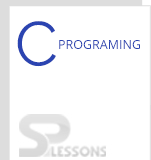 Description
Description
Unfortunately, structure in C-language does not have the capability of reducing the memory space. This back drop can be achieved by using Bit Field in C code.
If the structure members are specified in terms of bits, then it is called as "bit-field". They can be mainly used to increase the memory efficiency by giving a finite space to each member. Bit Field in C packs the data in a structure.
Some functions of Bit-fields
- Bit-fields behave as flags for determining the true or false values when required.
- If the bit field is empty, then that field can be accommodated to next coming bit.
- Portability of C decreases, if we use bit-fields as they maintain constant memory structure.
- Bit field are not given any address, so pointers don't work on bit-fields.
- The alternate to Bit Field in C are integers i.e. int or unsigned.
- Using bit-fields is suitable for low-level programming tasks because those machines support bit addressing.
- The main drawback is, bit-fields cannot be used for operators like sizeof() as they occupy the memory in terms of bytes.
- Bit Field Members shares the same bytes in a single word of memory.
 Syntax
Syntax
datatype bit-field_name :(length of bit-field)
where, data-type should always be int (or) unsigned.
Eg:
struct book
{
unsigned author : 4
unsigned page: 1
unsigned subject :2
};  Example
Example
[c]
#include<stdio.h>
int main()
{
struct bitfield
{
unsigned a1:3;
unsigned a2:5;
unsigned a3:4;
}bit;
char *p;
struct bitfield *ptr,bit1={1,3,3};
p=&bit1;
p++;
printf("%d",*p);
}[/c]
Output:
[c]
115[/c]
 Key Points
Key Points
- Bit fields increase the memory capability by considering the structure members size as the bits.
- There are no default initializers for bit-fields.



